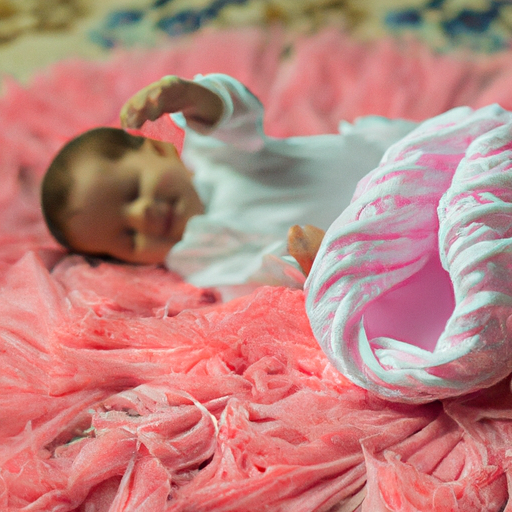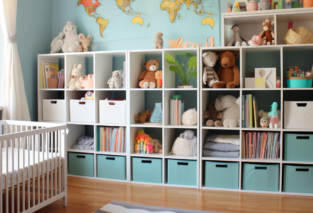So you’ve heard about swaddling and how it can help soothe your baby, but you’re not sure how to do it correctly. Well, you’ve come to the right place! In this article, we’ll guide you through the process of swaddling your baby properly, step by step. We’ll cover everything from choosing the right swaddle blanket to ensuring a snug but comfortable fit. By the end of this article, you’ll have all the knowledge you need to swaddle your baby like a pro.
Curious to learn more about swaddling your baby? We’ve got you covered! In the next few paragraphs, we’ll dive deeper into the benefits of swaddling, the different types of swaddle blankets available, and the dos and don’ts of swaddling. Whether you’re a first-time parent or just looking for some tips to improve your swaddling technique, this article is packed with valuable information that will help you master the art of swaddling. So, let’s get started and make sure your baby is snug and secure in their swaddle! Swaddling is a centuries-old practice that involves wrapping your baby snugly in a blanket. This age-old technique can provide numerous benefits for your little one, including better sleep, decreased fussiness, and a sense of security. In this article, we will explore the benefits and purpose of swaddling, when to start and stop swaddling, how to choose the right swaddling blankets, and the step-by-step process of swaddling your baby properly.
What is Swaddling?
Swaddling is the method of tightly wrapping a baby in a blanket to simulate the feeling of being in the womb. This gentle pressure can soothe newborns and promote better sleep. By recreating the cozy environment they experienced in utero, swaddling helps infants feel safe and secure in their new world outside the womb.
Benefits of Swaddling
Swaddling offers a variety of benefits for both babies and parents. Firstly, it can improve sleep quality. Research suggests that swaddled babies experience longer and more consolidated periods of sleep, which can be a relief for sleep-deprived parents. Swaddling also helps reduce the startle reflex, which often wakes babies up during sleep.
In addition to promoting sleep, swaddling can help soothe babies and reduce fussiness. The gentle pressure of the blanket can provide a sense of comfort and security, mimicking the feeling of being held. Swaddling may also help babies self-soothe and regulate their body temperature.
Furthermore, swaddling can make it easier for parents to handle their infants. The tight wrap of the swaddle can keep your baby’s arms and legs secure, making it easier for parents to hold and console them. Swaddling can also reduce the likelihood of accidentally scratching your baby’s face with their sharp nails.
Purpose of Swaddling
The main purpose of swaddling is to promote better sleep and soothe babies. As mentioned earlier, swaddling helps recreate the snug environment of the womb, which can calm your baby and make them feel safe. The feeling of being wrapped up can also help reduce the intensity of the startle reflex, allowing your baby to sleep more soundly.
Swaddling can also help babies feel more secure and prevent them from waking themselves up with their own movements. When babies are not swaddled, their flailing arms and legs can startle them awake. Swaddling prevents these movements, creating a more peaceful sleeping environment.
How Swaddling Helps Babies Sleep
Swaddling helps babies sleep by creating a cozy and secure environment that mimics the feeling of being in the womb. By restricting the movement of their arms and legs, swaddling prevents infants from startling themselves awake. This can lead to longer and more restful periods of sleep for both babies and parents.
When infants are swaddled, they are more likely to experience longer periods of REM sleep, which is crucial for brain development. The deep, uninterrupted sleep facilitated by swaddling allows babies to recharge and aids in healthy growth and development.
Swaddling can also provide comfort for babies who are used to being tightly nestled in the womb. The gentle pressure of the blanket can recreate the familiar feeling of being held, calming and soothing your infant.

When to Start Swaddling
Swaddling can typically begin right after birth, as long as your baby is healthy, and you feel comfortable doing so. Newborn swaddling can help them feel secure and safe during their transition into the world.
Newborn Swaddling
Newborns are often swaddled in the hospital by nurses, demonstrating just how safe and beneficial this practice is for babies. Swaddling can help newborns feel more secure and comfortable, as it mimics the snug environment of the womb. However, it is essential to follow safe swaddling guidelines to ensure your baby’s well-being.
Transitioning Out of Swaddling
As your baby grows and becomes more mobile, you may need to transition them out of swaddling. This typically happens around 2 to 4 months when babies start showing signs of rolling over. Rolling while swaddled can increase the risk of suffocation or injury, so it’s important to discontinue swaddling once your baby can roll onto their stomach.
To transition out of swaddling, you can gradually loosen the swaddle or switch to other sleepwear options like sleep sacks or tight-fitting pajamas. This allows your baby to maintain a sense of security while giving them the freedom to move.
Choosing the Right Swaddling Blanket
Selecting the right swaddling blanket is essential for ensuring your baby’s comfort and safety. Here are some factors to consider when choosing a swaddling blanket:
Material and Breathability
Opt for blankets made from soft, breathable fabrics like cotton or muslin. These materials are gentle on your baby’s delicate skin and allow for proper airflow, preventing overheating. Avoid blankets made of thick or synthetic materials that could cause your baby to overheat.
Size and Shape
Choose a blanket that is large enough to properly swaddle your baby. Ideally, the blanket should be around 40 inches square, allowing you to create a secure wrap. Ensure that the blanket is not too big or too small, as this can affect the effectiveness and safety of the swaddle.
Fastening Options
Consider the different fastening options available in swaddling blankets. Some blankets come with Velcro or snap closures, simplifying the swaddling process. These fasteners can help keep the blanket securely in place, preventing it from unraveling and posing a risk to your baby.
Preparing for Swaddling
Before you begin swaddling, it’s important to create a calm and peaceful environment. Here are some steps to follow:
Creating a Calm Environment
Find a quiet and soothing area in your home where you can comfortably swaddle your baby. Dim the lights, play some gentle music, or use white noise to create a relaxing atmosphere. Minimize distractions to ensure your baby can focus on settling down for sleep.
Gathering Swaddling Supplies
Before you begin swaddling, gather all the necessary supplies within reach. This includes your chosen swaddling blanket, extra diapers, and any other items you may need during the process. Having everything within arm’s reach will make the swaddling process easier and more efficient.
Ensuring a Safe Swaddling Area
Clear the swaddling area of any potential hazards. Make sure there are no loose objects or items that could pose a risk to your baby. Find a firm, flat surface like a bed or changing table to lay out the blanket and swaddle your baby. Always supervise your baby during the swaddling process and never leave them unattended on an elevated surface.
Step-by-Step Guide to Swaddling
Now that you have everything prepared, it’s time to learn how to swaddle your baby properly. Follow these step-by-step instructions:
Laying Out the Blanket
Spread the blanket on a flat surface in a diamond shape with one corner pointing towards you. Smooth out any wrinkles to ensure a clean and even wrap.
Placing the Baby on the Blanket
Place your baby on their back in the center of the blanket, ensuring their shoulders are aligned with the top edge of the blanket. Your baby’s head should be above the edge of the blanket.
Folding the Blanket for Swaddling
Take the corner of the blanket nearest to you and fold it over your baby’s chest, tucking it under their opposite arm. This helps restrict their arm movements and creates a snug wrap.
Securing the Swaddle
Next, take the bottom corner of the blanket and bring it up over your baby’s feet, tucking it into the top of the wrap. Ensure the blanket is snug but not too tight. Finally, take the remaining corner of the blanket and fold it over your baby’s chest, securing it with the earlier fold.

Common Mistakes to Avoid
While swaddling your baby, it’s important to avoid some common mistakes that could compromise their safety or comfort. Be mindful of the following:
Swaddling Too Tightly
Ensure that the swaddle is snug but not too tight. Swaddling too tightly can restrict your baby’s movement and breathing, potentially causing discomfort or even injury. Leave enough room for your baby to move their legs and hips comfortably.
Not Checking for Proper Hip Positioning
Always ensure that your baby’s hips are positioned correctly while swaddled. Their legs should be able to flex and spread out naturally at the hips to prevent hip dysplasia. Tight swaddling around the hips can cause issues with hip development.
Neglecting to Adjust for Baby’s Growth
As your baby grows, their swaddling needs may change. Regularly monitor your baby’s size and adjust your swaddling technique accordingly. It’s important to choose swaddling blankets that are appropriate for your baby’s age and size.
Monitoring the Baby’s Comfort and Safety
While swaddling your baby, it’s essential to monitor their comfort and safety. Here are some guidelines to follow:
Checking for Overheating
Ensure that your baby does not become too hot while swaddled. Overheating can increase the risk of sudden infant death syndrome (SIDS). Check your baby’s temperature by feeling their tummy or back. If they feel hot or sweaty, consider removing a layer or adjusting the swaddle to promote airflow.
Watching for Signs of Discomfort
Pay attention to your baby’s cues while swaddled. If they seem uncomfortable, restless, or fussy, it may be a sign that they need adjustment or may prefer a different sleep environment. Each baby is unique, so it’s important to be responsive to your baby’s individual needs and preferences.
Ensuring Proper Airflow
Avoid tightly wrapping your baby’s face or neck area when swaddling. The swaddle should be snug on their body but allow for proper airflow around their face. This ensures that your baby can breathe freely and reduces the risk of suffocation.
Swaddling Alternatives
While swaddling can be incredibly beneficial, it may not be suitable for all babies or parents. Here are some swaddling alternatives you can consider:
Sleep Sacks
Sleep sacks are wearable blankets that allow your baby’s arms and legs to move freely while still providing a cozy, secure feeling. Sleep sacks come in various sizes and styles, ensuring a safe and comfortable sleep environment for your little one.
Merlin’s Magic Sleepsuit
Merlin’s Magic Sleepsuit is a specially designed sleep garment that provides a cozy and secure environment for babies transitioning out of swaddling. It offers the same snug feeling of a swaddle while allowing for more movement.
Tight-Fitting Pajamas
If your baby no longer enjoys being swaddled or wearing sleep sacks, tight-fitting pajamas can provide a similar sense of security. These pajamas help create a snug feeling against your baby’s body without completely restricting their movement.
Tips for Successful Swaddling
Here are some additional tips to ensure successful swaddling:
Maintain a Consistent Swaddling Routine
Establish a consistent swaddling routine with your baby. Babies thrive on predictability, and a consistent swaddling routine can signal to your little one that it’s time for sleep. Consistency can also help your baby associate swaddling with the feeling of comfort and security.
Practice and Patience
Swaddling may take some practice to perfect. Don’t get discouraged if it doesn’t go smoothly at first. Keep practicing and be patient with yourself and your baby. With time, you’ll become more comfortable and efficient in swaddling your little one.
Seeking Professional Guidance if Needed
If you’re uncertain about how to swaddle your baby properly or have any concerns, don’t hesitate to seek guidance from a medical professional. They can provide personalized advice and ensure you’re using the correct techniques for your baby’s specific needs.
Conclusion
Swaddling is a time-honored tradition that can provide numerous benefits for both babies and parents. When done correctly, swaddling can promote better sleep, decrease fussiness, and create a calming environment for your baby. By choosing the right swaddling blanket, following safe swaddling techniques, and monitoring your baby’s comfort and safety, you can ensure a successful and soothing swaddling experience for your little one. Remember, each baby is unique, so pay attention to your baby’s cues and adjust your swaddling routine as needed. With practice and patience, you’ll discover the best swaddling techniques that work for you and your baby, helping everyone get a good night’s sleep.





